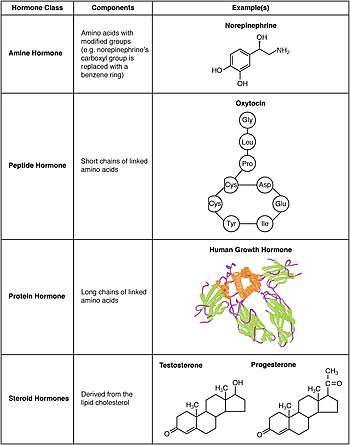Endogeny (biology)
Endogenous substances and processes are those that originate from within a system such as an organism, tissue, or cell.[1] The term is chiefly used in biology but also in other fields.[nb 1]

Endogenous substances and processes contrast with exogenous ones, such as drugs, which originate from outside of the organism.
Endogenous substances
Cell signalling systems such as hormone and neurotransmitter systems use endogenous substances. Endogenous substances can regulate sleep.[2]:1 Examples of endogenous substances, and systems that use them, include
- The endogenous cannabinoid system, from which the term "endocannabinoid" derives. The endocannabinoid system is important in physiology but can be modulated by phytocannabinoids originating from outside the organism, such as THC.[3]
- Endogenous steroids.[4]:261
- Endogenous opioids, which are peptides such as enkephalins and endorphins, that can modulate the opioid system.[5] The term "endorphin" is derived from "endogenous morphine".
- Nitric oxide, which is an endogenous cell signalling molecule.[6] Nitric oxide was identified as the substance previously known as endothelium-derived relaxing factor (EDRF), which was known to be an endogenous substance responsible for the relaxation of vascular endothelium.
- Sulfur dioxide.[7]
Endogenous transcription factors are those manufactured by the cell, as distinguished from cloned transcription factors.
Endogenous substances typically have some physiological utility, but they can also be pathologically endogenous. For example, in auto-brewery syndrome, ethanol is endogenously produced within the digestive system through endogenous fermentation of sugars.
Endogeneity can, in some biological systems (particularly with viruses and prokaryotes), pertain to DNA incorporated (endogenized) into the organism.[8] However, because of homeostasis, discerning between internal and external influences is often difficult. Endogenous viral elements, which are DNA sequences derived from viruses that are ancestrally inserted into the genomes of germ cells. These sequences, which may be fragments of viruses or entire viral genomes (proviruses), can persist in the germline, being passed on from one generation to the next as host alleles. Endogenous retroviruses are a type of endogenous viral element.
Endogenous processes
Endogenous effects can modulate and regulate systems, in conjunction with environmental influences.[9]:8
Endogeny can refer to changes that originate from within a system.[9]:8 Endogenous changes can occur in social systems and can be modelled by Marxian dialectics.[9]:8
Orthogenesis is a similar concept to endogeny but refers to changes within separate systems that results in their evolution along similar paths.[9]:8 The concept of orthogenesis has never been widely favored in evolutionary biology.[9]:8
Examples of endogenous processes include:
- Senescence (biological aging)
- The menstrual cycle
- The self-sustained circadian rhythms of plants and animals.
- Endogenous regeneration, which refers to the ability of cells to engage in the repair and regeneration process.
- Endogenous biological clocks and biological rhythms originating from endogenous mechanisms allow forms of biochronometry.[10]:281–282
Endogenous processes can also be pathological. For example, endogenous depression is an atypical type of depression caused by internal effects, such as cognitive and biological stressors.
See also
Notes
- The term has also been applied to sociological concepts. See (Vasey 2002 p. 8).
References
- "Endogenous | Define Endogenous at Dictionary.com". Dictionary.reference.com. Retrieved 2011-07-11.
- Inoue, Shojiro (1989-03-31). Biology of Sleep Substances. CRC Press. ISBN 9780849348228.
- Nast, Condé. "Here's How Weed Use Can Improve Your Sex Life". Allure. Retrieved 2019-06-19.
- Ananchenko, S. N. (1980). Frontiers of Bioorganic Chemistry and Molecular Biology: Proceedings of the International Symposium on Frontiers of Bioorganic Chemistry and Molecular Biology, Moscow and Tashkent, USSR, 25 September - 2 October 1978. Elsevier. ISBN 9781483278834.
- Akil, Huda; Watson, Stanley J.; Young, Elizabeth; Lewis, Michael E.; Khachaturian, Henry; Walker, J. Michael (1984). "Endogenous Opioids: Biology and Function". Annual Review of Neuroscience. 7 (1): 223–255. doi:10.1146/annurev.ne.07.030184.001255. PMID 6324644.
- Ignarro, Louis J. (1999-04-01). "Nitric Oxide: A Unique Endogenous Signaling Molecule in Vascular Biology". Bioscience Reports. 19 (2): 51–71. doi:10.1023/A:1020150124721. ISSN 1573-4935. PMID 10888468.
- Chen S, Zheng S, Liu Z, Tang C, Zhao B, Du J, Jin H (Feb 2015). "Endogenous sulfur dioxide protects against oleic acid-induced acute lung injury in association with inhibition of oxidative stress in rats". Lab. Invest. 95 (2): 142–156. doi:10.1038/labinvest.2014.147. PMID 25581610.
- Clément Gilbert; Feschotte, Cédric (2012). "Endogenous viruses: insights into viral evolution and impact on host biology" (PDF). Nature Reviews Genetics. 13 (4): 283–296. doi:10.1038/nrg3199. ISSN 1471-0064. PMID 22421730.
- Vasey, Daniel E. (2002). An Ecological History of Agriculture 10,000 B.C.-A.D. 10,000. Purdue University Press. ISBN 9781557532725.
- Palmer, John (2012-12-02). An Introduction to Biological Rhythms. Elsevier. ISBN 9780323152426.
External links
